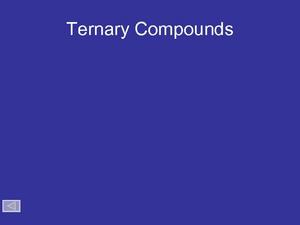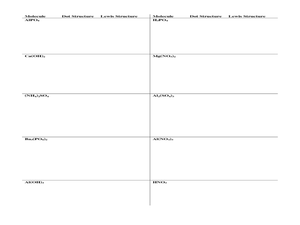Virginia Department of Education
Matter and Energy: Equations and Formulas
Using simple materials, an informative lesson demonstrates the Law of Conservation of Matter and explains how to balance chemical equations. Young chemists perform experiments, analyze reactions, and balance chemical equations on their...
Curated OER
Review of Ionic and Covalent Compounds and Transitioning from Ionic to Covalent Compounds
Here is a unique assigment: compare and contrast ionic and covalent compounds in an extensive data table and then analyze Lewis dot structures in antoher. Three columns are to befilled in: "characteristic or feature," "applies to ionic...
Curated OER
Ternary Compounds
Practice naming ternary compounds with this PowerPoint presentation. Individual slides show the patterns for memorizing the nomenclature for polyatomic ions. Several examples are included for student practice. This thorough and...
Royal Society of Chemistry
Some A-level Reagents
Learning names and formulas can be a daunting task for young chemists, so support their study with interactive puzzles! First, users match each formula with its correct name. Then, individuals use them to complete three logic games.
Royal Society of Chemistry
Complex Ion Shapes
Things are really shaping up! Provide young chemists with polyatomic ion practice using an interesting interactive. Individuals complete puzzles focused on molecular geometry and complex ions.
Royal Society of Chemistry
Compounds Ending in 'ate'
Tackle polyatomic ions with Sudoku-like games! Nomenclature novices practice identifying the names and constituents of carbonate compounds with a series of puzzles. Scholars can use the resource online or as a worksheet, thanks to the...
Curated OER
The Nature of Covalent Bonding
In "The Nature of Covalent Bonding," chemistry hopefuls demonstrate an understanding of various types of covalent bonds, electron configuration, and resonance structures through fill in the blank, true or false, and matching questions....
Curated OER
Covalent and Ionic Bonding:Electron Dot Structures with Ionic Notation
After drawing the valence electron distribution of 13 basic elements, there are spaces to draw 18 more complicated molecules. For each molecule, there is space for a Dot structure and Lewis structure that best describes the distribution...
Curated OER
Polyatomic Ions
Opening with a chart of common polyatomic ions, and finishing with an explanation of how to name polyatomic ions, this presentation is to the point. The links on the vocabulary page do not work, leaving you only a few slides to work...
Curated OER
What Happens When Chemicals are Put Together?
In this ionic compounds worksheet, high schoolers complete two tables with the chemical formulas given the cations and anions that bond.
Curated OER
Naming and Writing Chemical Formulae-I
In this naming and writing chemical formulas worksheet, students are given directions and practice writing simple chemical formulas. They identify positive and negative valence elements, they name nonmetal compounds, they name compounds...
Curated OER
Naming and Covalent Compounds
In this naming and covalent compounds worksheet, learners name 12 compounds using a chart of polyatomic ions if needed. They also draw covalent bonds in 6 compounds and answer 6 questions about ionic bonds, covalent bonds and polyatomic...
Curated OER
Naming: Putting it all Together
In this naming compounds worksheet, learners are given a flow chart guiding them to name chemical compounds. They are given several different compounds to name including binary covalent and binary ionic compounds.
Curated OER
Writing Formulas by Crossing Over
In this formulas worksheet, students use the cross-over rule to determine the formula for compounds of the elements and polyatomic ions given. Students complete 15 problems.
Curated OER
Naming and Writing Formulas for Simple and Complex Ionic Compounds
In this naming compounds instructional activity, students write and name the formulas for 20 ionic compounds including simple and complex compounds.
Curated OER
Electron Dot Structures/Lewis Structures
In this elements worksheet, students practice drawing electron dot structures for atoms. Students draw the Lewis Structures for molecules with single and multiple bonds plus polyatomic ions. This worksheet has 33 problems to solve.
Curated OER
Ionic Chemical Formulas Days 1 & 2
Students study polyatomic ions and write binary and ternary ionic chemical formulas. They explore putting together different monatomic ions and coming up with as many chemical formulas as possible. They play a game similar to memory...
Curated OER
Oxyanions
In this oxyanions worksheet, students identify the common polyatomic ions. They write formulas and name polyatomic ions based on IUPAC rules.
Curated OER
Lewis Structures, VSEPR, Polarity, IM Forces
In this compounds worksheet, students draw the Lewis structures, indicating the molecular polarity and the major intermolecular force in each compound. This worksheet has 10 problems to solve.
Curated OER
Using the Stock System
In this compounds worksheet, students learn the rules for naming compounds, the stock system. Students apply these rules by writing the names or formulas for the 20 given compounds.
Curated OER
Naming and Writing Formulas for Ionic Compounds
For this ionic compounds worksheet, learners fill in 8 blanks with the appropriate terms, they determine if 4 statements are true or false, they match 4 terms with their definition and they name and write the formulas of compounds....
Curated OER
Naming Ionic Compounds with Complex Ions
For this naming compounds worksheet, students name 20 given ionic compounds using complex ions. They use the periodic table and an ion chart to help name the compounds.
Curated OER
Writing Formulas for Ionic Compounds
In this writing formulas activity, high schoolers write the formulas for 15 ionic compounds and name their anions and cations. Students balance the charges of the ions to determine the formula.
Curated OER
Writing Formulas for Ionic Compounds with Complex Ions
In this writing formulas worksheet, learners write the formulas for 15 complex ionic compounds and name their anions and cations. Students must balance the charges on the ions and determine the formula.

























